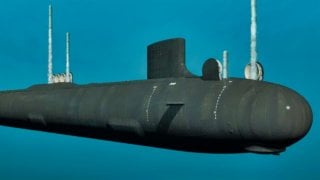USS New Jersey: The Navy's Block IV Virginia-Class Submarine Is a Beast
The USS New Jersey, a World War II Iowa-class battleship and floating museum, is set for refurbishment. At the same time, the Block IV Virginia-class attack submarine PCU New Jersey (SSN 796) has completed its initial sea trials.
Summary: The USS New Jersey, a World War II Iowa-class battleship and floating museum, is set for refurbishment, while the Block IV Virginia-class attack submarine PCU New Jersey (SSN 796) has completed its initial sea trials. Conducted by Huntington Ingalls Industries' Newport News Shipbuilding, the trials tested the submarine's systems, components, and capabilities, including its first submersion and high-speed maneuvers. The twenty-third Virginia-class submarine, SSN 796, christened in November 2021, is set for Navy delivery and commissioning on September 14, 2024. It represents a significant evolution in submarine technology, designed for gender integration, and enhanced with the Virginia Payload Module for increased armament capacity.
More Virginia-Class Submarines are Coming Soon
The World War II Iowa-class battleship USS New Jersey (BB-62) is about to head for a much-needed refurbishment that will ensure the retired warship will continue to serve as a floating museum for decades to come. However, another vessel named for the Garden State completed its initial sea trials.
The Block IV Virginia-class attack submarine PCU New Jersey (SSN 796) spent several days at sea to test the boat's systems and components, Huntington Ingalls Industries' Newport News Shipbuilding division announced on Thursday. Testing reportedly included submerging the submarine for the first time and conducting high-speed maneuvers while on the surface and submerged. NNS teams will continue the testing program ahead of delivering the boat to the U.S. Navy.
"Taking New Jersey out for the first time is a significant milestone and the first major test of the submarine's capabilities at sea," said Jason Ward, NNS vice president of Virginia-class submarine construction. "Both New Jersey and her crew performed exceptionally well. This was truly a team effort between shipbuilders, thousands of suppliers around the country and the crew. We look forward to delivering New Jersey to the Navy soon so it can begin its service to our nation."
The boat, the twenty-third Virginia-class submarine, was christened in November 2021 and will be the eleventh to be delivered by NNS. The future USS New Jersey is on track to be commissioned on September 14, 2024. She is the third U.S. Navy vessel to be named for New Jersey – after the Virginia-class battleship and the aforementioned Iowa-class battleship.
Block IV Virginia-Class Submarine
In addition to being the first attack submarine designed with a modification for gender integration, SSN 796 is one of the ten Block IV submarines of the Virginia-class.
The submarines displace 7,835 tons, with a hull length of 377 feet and a diameter of 34 feet, and can attain speeds of 25 knots with the power from its nuclear reactor. Each of the Block IV boats can dive to more than 800 feet.
The submarines feature Mark 48 advanced capability torpedoes and Tomahawk cruise missiles. The boats are equipped with the Virginia Payload Module, an 84-foot-long, mid-ship section that has four large-diameter, vertical launch tubes for keeping and launching more Tomahawks and other payloads.
The Block IV boats incorporate design changes that were focused on reduced total ownership cost. By making these smaller-scale design changes to increase the component-level lifecycle of the submarine, the U.S. Navy was able to increase the periodicity between depot maintenance availabilities and increase the number of deployments. The main improvement of the Block IV over the preceding Block III is the reduction of major maintenance periods from four to three, increasing each boat’s total lifetime deployments by one.
The Virginia-class boats are currently the U.S. Navy's primary attack submarine for land, surface, and anti-submarine attack missions, and its armaments include cruise missiles and torpedoes. Each is also equipped with a large lock-in/lock-out chambers that allow Navy SEALs to operate from the boat, while there are future plans for it to be used to launch underwater drones. Instead of the traditional periscopes this class of submarines utilizes two photonics masts that host visible and infrared digital cameras atop telescoping arms.
Author Experience and Expertise: Peter Suciu
Peter Suciu is a Michigan-based writer. He has contributed to more than four dozen magazines, newspapers, and websites with over 3,200 published pieces over a twenty-year career in journalism. He regularly writes about military hardware, firearms history, cybersecurity, politics, and international affairs. Peter is also a Contributing Writer for Forbes and Clearance Jobs. You can follow him on Twitter: @PeterSuciu. You can email the author: [email protected].


